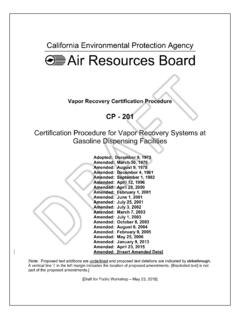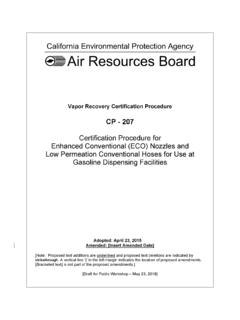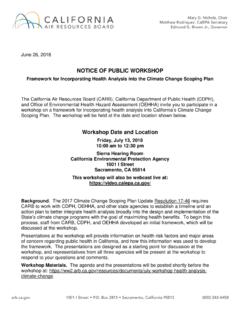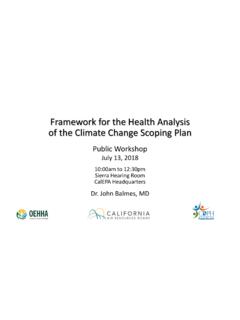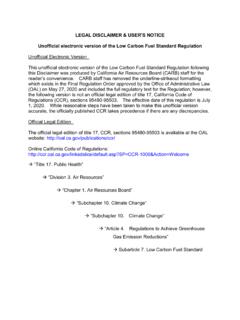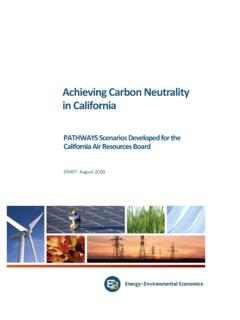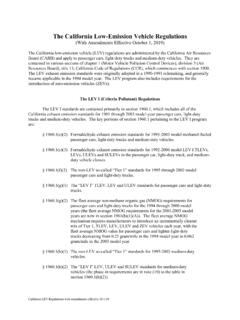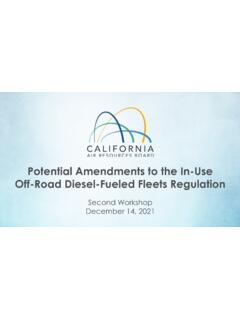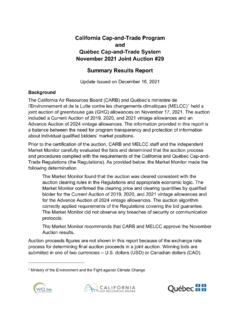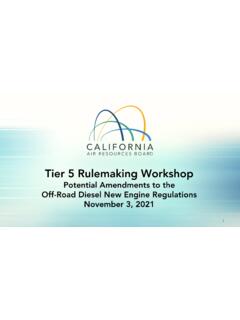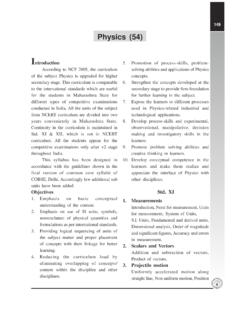Transcription of Final Regulation Order - ww2.arb.ca.gov
1 Final Regulation Order California Code of Regulations, Title 17, Division 3, Chapter 1, Subchapter 10 Climate Change, Article 4 [Note: The amendments to existing regulatory language are shown in strikethrough to indicate deletions and underline to indicate additions, respectively] Amend sections 95371, 95372, 95373, 95374, 95375, 95377, and 95378, repeal section 95376, and adopt sections 95376 and 95379, Article 4, Subarticle 5, Chapter 1, Division 3, Title 17, California Code of Regulations to read as follows: Prohibitions on Use of Certain Hydrofluorocarbons in Stationary Refrigeration, Stationary Air-conditioning, Chillers, Aerosols-Propellants, and Foam Other End-Uses Subarticle 5. Prohibitions on Use of Certain Hydrofluorocarbons in Stationary Refrigeration, Stationary Air-conditioning, Chillers, Aerosols-Propellants, and Foam Other End-Uses 95371.
2 Purpose. The purpose of this subarticle is to reduce hydrofluorocarbon (HFC) emissions by adopting specific prohibitions for certain substances in refrigeration, air-conditioning, chillers, ice rinks, cold storage, aerosols-propellants, and foam end-uses to support California s progress toward the 2030 greenhouse gas emission reduction goals and hydrofluorocarbon emissions reduction targets as well as the Short Lived Climate Pollutant Strategy. NOTE: Authority cited: Sections 38510, 38598, 38560, 38562, 38566, 38580, 39600, 39601, 39730, , 39734 and 41511, Health and Safety Code. Reference: Sections 38510, 38598, 38560, 38562, 38566, 38580, 39600, 39601, 39730, , 39734 and 41511, Health and Safety Code. 95372. Applicability. This subarticle applies to any person who sells, leases, rents, installs, uses, or otherwiseenters into commerce, in the State of California, any product, equipment, 1 material, or substance in end-uses listed in Table 1, section 95374(a),; Table 2, section 95374(b); Table 3, section 95374(c); or Table 4, section 95374(d) of this subarticle.
3 NOTE: Authority cited: Sections 38510, 38598, 38560, 38562, 38566, 38580, 39600, 39601, , 39734 and 41511, Health and Safety Code. Reference: Sections 38510, 38598, 38560, 38562, 38566, 38580, 39600, 39601, 39730, , 39734 and 41511, Health and Safety Code. 95373. Definitions. (a)For the purposes of this subarticle, excepting sections 95374(b) and 95376, the following definitions shall apply: Aerosol means a product with a pressurized spray system that dispenses product ingredients by means of a propellant contained in a product or a product's container, or by means of a mechanically induced force. Air-conditioning (AC) Equipment or Air-conditioning System means equipment that cools, heats or dehumidifies spaces in residential or non-residential settings for comfort cooling and other purposes, including, but not limited to, room air conditioning such as window units, packaged terminal air conditioners (PTACs), packaged terminal heat pumps (PTHPs), residential dehumidifiers, and portable air conditioners; ducted central air conditioners and heat pumps; non-ducted air conditioners and heat pumps (both mini-and multi-splits); packaged rooftop units; water-source and ground-source heat pumps; and other dehumidifiers.
4 Air-conditioning equipment also includes computer room and data center cooling and remote condensing units for comfort cooling applications. Chillers are defined separately from air-conditioning equipment. Air-conditioning equipment refers to stationary air-conditioning equipment and does not include mobile air-conditioning equipment, including that used in vehicles, rail and trains, buses, aircraft, watercraft, recreational vehicles, recreational trailers, and campers. Air District means an air quality management district or air pollution control district created or continued in existence under Health and Safety Code sections 40000-41357. Air Pollution Control Officer or APCO" means the appointed head of a local air quality management district or air pollution control district (Air District) whose appointment and duties are set forth in Health and Safety Code sections 40750-40753. Applicant means any person who sells, leases, rents, installs, uses, or otherwise enters into commerce, in the State of California, any substance in end-uses listed in Table 1, section 95374(a); Table 2, section 95374(b); Table 3, section 95374(c); or Table 4, section 95374(d) of this subarticle who applies for a variance under section 95378 of this subarticle.
5 Trade groups are not applicants. 2 Baseline Greenhouse Gas Potential or Baseline GHGp means the greenhouse gas potential (GHGp) of a company s retail food facilities at the end of calendar year 2019. The baseline GHGp will be revised when any of the following occur: (1)Retail food facilities that are sold or transferred will be removed from the baseline GHGp. (2)Acquired retail food facilities will be added to the baseline GHGp using their 2019 GHGp levels, and the current GHGp of acquired stores will be used to calculate the current GHGp. Bear Spray means an aerosol that has active ingredients of capsaicin and related capsaicinoids and is used to deter aggressive or charging bears. Blowing Agent or Foam Blowing Agent or Foam Expansion Agent or Foaming Agent is means a substance that functions as a source of gas to generate bubbles or cells in the mixture during the formation of foamwhich is capable of producing a cellular structure via a foaming process in a variety of materials that undergo hardening or phase transition, such as polymers and plastics.
6 Blowing agents are typically applied when the blown material is in a liquid stage. Capital Cost means an expense incurred in the production of goods or in rendering services, including, but not limited to, the cost of engineering, purchase, and installation of components or systems, and instrumentation, and contractor and construction fees. Certified Reclaimed Refrigerant means used (recovered) refrigerant that has been reclaimed by a EPA-certified refrigerant reclaimer from a previously operational appliance and meets all of the following conditions: (1)Meets all specifications in 40 Part 82, Subpart F, Appendix A (Specifications for Refrigerants) (January 1, 2017), which is incorporated herein by reference; (2) Must have results of the analysis conducted to verify that reclaimed refrigerant meets the necessary specifications as required in (1) above; and (3)Contains no greater than fifteen percent (15%) new (virgin) refrigerant by weight to meet the specifications in 40 , Part 82, Subpart F, Appendix A (Specifications for Refrigerants) (January 1, 2017).
7 The certified reclaimer must have documentation that supports it has not exceeded the maximum allowable virgin refrigerant content. 3 Change in Ownership means a transfer of the title of a facility subject to this subarticle. Charge or Refrigerant Charge means the amount of refrigerant by mass contained in a refrigeration system. Charge is generally measured by grams, ounces, pounds, or kilograms. Charge Reduction means to reduce the refrigerant full charge amount through a mechanical system change in the refrigeration circuit and not simply through a nominal full charge change. Chiller means a water or heat transfer fluid chilling equipment package custom built in place, or a factory-made and prefabricated assembly of one (1) or more compressors, condensers and evaporators, with interconnections and accessories including controls, designed for the purpose of cooling or heating water or a heat transfer fluid.
8 A chiller is a machine specifically designed to make use of a vapor compression refrigeration cycle or absorption refrigeration cycle to transfer heat from a cold water or heat transfer fluid circulating system to the air, a heat transfer fluid, or another heat exchange media. Chillers can be water-cooled, air-cooled, or evaporatively cooled, and include, but are not limited to, rotary chillers, centrifugal chillers, and positive displacement chillers, including reciprocating, scroll, and screw chillers. Chillers include those used for comfort cooling, space and area cooling, or industrial process cooling. A chiller used for refrigeration in a retail food facility is considered an indirect type of supermarket system. Class I Substance means any ozone-depleting compound defined in the Clean Air Act, as amended, 42 section 7671(3) (effective November 15, 1990). Class II Substance means any ozone-depleting compound defined in the Clean Air Act, as amended, 42 section 7671(4) (effective November 15, 1990).
9 Cold Storage means a refrigerated facility or warehouse used for the storage of temperature-controlled substances. Commercial Ice Machine means a non-residential ice machine and/or ice maker used in a commercial establishment to produce ice artificially for consumer use, including, but not limited to, a hotel, restaurant, or convenience store. Company means all businesses, affiliates, brands, or subsidiaries or franchises, owned or operated by the same parent company. 4 Component means a part of a refrigeration system, including, but not limited to, condensing units, compressors, condensers, evaporators, and receivers; and all of its connections and subassemblies, without which the refrigeration system will not properly function or will be subject to failures. Cumulative Replacement means the addition of or change in multiple components within a three-year period.
10 Date of Manufacture means: (1)For foam imported into the state, the date that the foam was initially manufactured; (2)For foam systems imported into the state, the date that the polyurethane blend and isocyanate were packaged or labeled; (3)For chillers and air-conditioning and refrigeration equipment, the date that the manufacturer affixed an equipment label indicating the equipment s date of manufacture; or (4) For refrigeration and air-conditioning equipment built-up and completed on site, the date that the refrigerant circuit was completed and initially filled with refrigerant. End-use means processes or classes of specific applications within industry sectors, such as those listed in Tables 1 through 4 of section 95374 of this subarticle. Executive Officer means the Executive Officer of the California Air Resources Board or his or her delegate. Executive Order means an Order issued by the Executive Officer of CARB that authorizes a variance from the requirements of sections 95374 and 95375, and specifies the variance duration with enforceable conditions and requirements necessary to support the variance.
